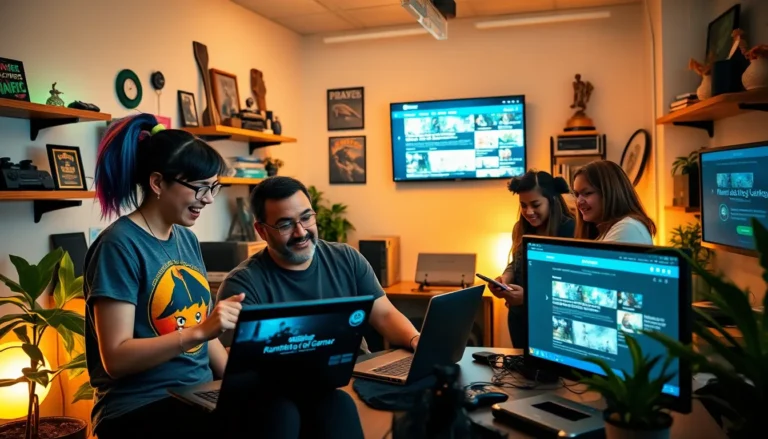Table of Contents
ToggleEver wondered how to unlock the secrets of ChatGPT and make it spill the beans on just about anything? You’re not alone. Many users find themselves staring at the screen, pleading for the AI to reveal its wisdom. The truth is, with the right approach, you can turn this digital oracle into your personal knowledge guru.
Understanding ChatGPT
ChatGPT is a powerful AI language model designed to engage in human-like conversations. Users can harness its capabilities to access vast amounts of information.
What Is ChatGPT?
ChatGPT is an AI chatbot created by OpenAI. Its primary function is to generate text-based responses that mimic human interaction. Developers trained ChatGPT using diverse data sources, enhancing its understanding of various topics. Engaging with users in a conversational style makes it a useful tool for obtaining information. Many applications utilize ChatGPT, including virtual assistants and customer support.
How Does ChatGPT Work?
ChatGPT operates on a transformer architecture, which allows it to process and generate language. It analyzes input text by predicting the next word based on preceding context. Training involves processing extensive text data, enabling the model to learn patterns and meanings. As users interact with ChatGPT, it continuously learns from conversations, improving its responses. The model’s ability to provide relevant information relies on its training dataset and user prompts.
Tips for Effective Prompting
Engaging with ChatGPT effectively requires skillful prompting techniques. Users should focus on crafting specific inquiries to glean valuable information.
Crafting Clear Questions
Clear questions yield better responses. Start with direct inquiries that target specific information. For example, instead of asking, “Tell me about dogs,” use “What are the top three breeds of dogs for families?” This specificity guides ChatGPT toward relevant answers. Avoid vague language; articulate expectations to foster understanding. Additionally, breaking complex queries into simpler parts can clarify the request. A straightforward structure simplifies the processing of information.
Using Contextual Information
Providing context enriches interaction. Begin by sharing relevant background details about the topic. For instance, when asking for statistics, including the time frame or specific region can enhance accuracy. Saying “Provide the latest statistics on renewable energy in 2023” directs ChatGPT to focus on recent data rather than older information. Continuously build on previous interactions to develop a more dynamic conversation. Context helps in aligning responses with user intent, resulting in more targeted and useful replies.
Techniques to Extract Information
Engaging with ChatGPT effectively requires specific techniques to maximize information extraction.
Role-Playing Scenarios
Utilizing role-playing scenarios can enhance interactions with ChatGPT. By framing questions within a particular context, users can access tailored responses. For instance, asking ChatGPT to act as a travel guide for Paris leads to insights about popular attractions, dining options, and cultural experiences. Adopting different perspectives allows ChatGPT to provide more detailed and relevant information. Users should specify roles clearly to guide the AI’s responses. This method fosters a more immersive dialogue, making the information gained richer and more applicable.
Iterative Questioning
Iterative questioning promotes deeper exploration of topics with ChatGPT. By asking follow-up questions, users can refine the direction of the conversation. Initial inquiries can lead to broader discussions when additional context or clarification is provided. Instead of settling for a single response, users should leverage previous answers to form new queries. This back-and-forth engagement encourages ChatGPT to dig deeper and uncover insights that align with users’ needs. Structured questioning allows for a more comprehensive understanding of complex subjects, resulting in quality information extraction.
Limitations of ChatGPT
ChatGPT has several limitations that can impact its effectiveness as a source of information. Understanding these constraints helps users navigate interactions more effectively.
Areas Where ChatGPT Struggles
One significant area of difficulty involves specialized knowledge. ChatGPT may lack up-to-date insights on emerging trends or niche topics. It sometimes fails to provide accurate information on highly detailed subjects like medical conditions or technical processes. Context-specific queries often lead to vague or incomplete answers. Additionally, real-time data retrieval is beyond its capabilities, limiting responses to information up to 2021. When discussing recent events, users might encounter outdated references, leading to confusion.
Misinterpretations and Ambiguities
Misinterpretations frequently arise during interactions with ChatGPT. Ambiguous prompts may result in responses that don’t align with user expectations. For instance, a question with multiple interpretations can lead the AI down an unintended path. Clarifying context is crucial; without it, the AI may misinterpret key elements. Language nuances also present challenges, as subtle differences in phrasing can change the meaning entirely. Users should provide specific context and structure their questions to minimize misunderstandings.
Harnessing the full potential of ChatGPT requires a strategic approach to interaction. By asking clear and specific questions users can guide the AI toward more accurate and relevant responses. Incorporating context and utilizing techniques like role-playing and iterative questioning can significantly enhance the quality of information gathered.
While ChatGPT is a powerful tool for knowledge extraction it has limitations that users should keep in mind. Understanding these constraints allows for a more effective engagement. With practice and the right techniques anyone can transform their experience with ChatGPT into a valuable resource for information and insights.







